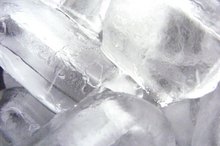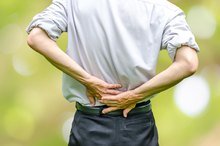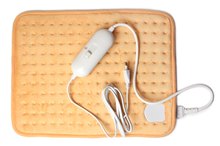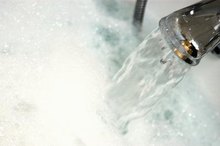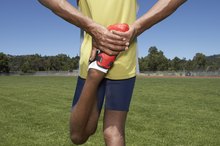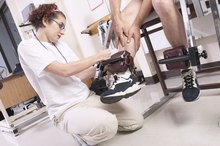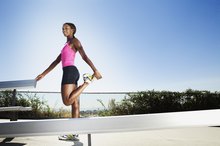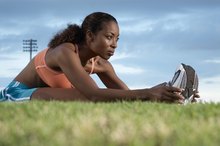How to Soak to Prevent or Relieve Leg Cramps
Common complaints among athletes include mid-exercise and post-exercise cramping. Muscle cramping is most often brought on by a combination of tight muscles, extreme weather, improper hydration and/or electrolyte depletion. Cramps can be treated and prevented by relaxing the muscle, rehydrating and balancing electrolyte levels in the body. Soaking in either a hot or cold whirlpool may provide relief. If possible, speak with a health care professional to determine which soak is more appropriate for your condition.
Warm Water Bath
Check with your medical provider prior to starting a soaking regimen. With precautions, these soaks can be done at home. Gather all materials necessary to complete the warm water soak.
Homemade Epsom Salt Poultice
Learn More
Fill bath with hot water, monitoring the temperature as it fills. Adjust water temperature to read between 90 degrees and 104 degrees Fahrenheit. Warm water soaks will relax tight muscles but can burn skin if the water is too hot.
Measure 1/2 cup to 1 cup epsom salt into the bath. For best absorption of salt, allow epsom salt to dissolve completely in warm water soak.
How to Ice Swollen Legs & Feet
Learn More
Stretch the muscle during the soak. Hold stretches for 20 to 30 seconds at a time allowing for the muscle to relax. Stretching combined with heat will increase blood flow to the area and decrease muscle spasm and pain.
Soak muscles in hot water for 15 to 30 minutes. To further relax the muscle, massage the area after soaking. This will also help relieve cramping after a warm water bath.
- Check with your medical provider prior to starting a soaking regimen.
- Stretching combined with heat will increase blood flow to the area and decrease muscle spasm and pain.
Ice Water Bath
Draw cold water into the bathtub while gathering the ice and thermometer. Ice should be set to the side of the cold water bath. Get into the cold water bath. The ice will be added in gradually as tolerated.
Measure water temperature. Adjust ice bath temperature at comfort level keeping the temperature higher than 50 degrees but cooler than 60 degrees Fahrenheit.
Soak in ice bath for five to 20 minutes as tolerated. Beware of signs of hypothermia or frostbite on extremities.
Massage the area after soaking. Massage will help bring back blood flow to the area after an ice bath.
Tips
Cold therapies are most beneficial within 48 hours of injury. Ice water acts as an analgesic to help relieve pain and decrease the intensity and frequency of cramps. According to a study published in The Journal of Athletic Training, cold therapies or a combination of hot and cold therapies (contrast bath) have been more effective than heat therapy alone to decrease muscle soreness.
Warnings
Diabetics and others with poor circulation should consult with their doctor prior to soaking. When choosing a therapy, understand that heat should never be applied until at least 48 hours after injury. Heat soaks will increase circulation to an area, which can cause swelling.
- Draw cold water into the bathtub while gathering the ice and thermometer.
Related Articles
References
- Sports Injury Clinic: Calf Cramp
- Journal of Athletic Training: Effect of Whirlpool Therapy
- "The Practical Guide to Athletic Training"; Ted Eaves; 2009
- Mooventhan A, Nivethitha L. Scientific evidence-based effects of hydrotherapy on various systems of the body. N Am J Med Sci. 2014;6(5):199-209. doi:10.4103/1947-2714.132935
- Montano et al. Cold Water Immersion for Recovery: Acute and Chronic Effects on Exercise Performance. Int J Res Ex Phys. 13(2):43-52.
- Jones PR, Barton C, Morrissey D, Maffulli N, Hemmings S. Pre-cooling for endurance exercise performance in the heat: a systematic review. BMC Med. 2012;10:166. Published 2012 Dec 18. doi:10.1186/1741-7015-10-166
- Bieuzen F, Bleakley CM, Costello JT. Contrast water therapy and exercise induced muscle damage: a systematic review and meta-analysis. PLoS One. 2013;8(4):e62356. Published 2013 Apr 23. doi:10.1371/journal.pone.0062356
Writer Bio
Kristen McCarty started writing wellness articles for students and faculty in 2007. She has worked as a certified athletic trainer and health educator at the collegiate and secondary school levels. She now writes for LIVESTRONG.COM. She holds a Bachelor of Science in sports medicine concentrating in athletic training from Mercyhurst College and a Masters of Arts in applied physiology from Teachers College-Columbia University.

